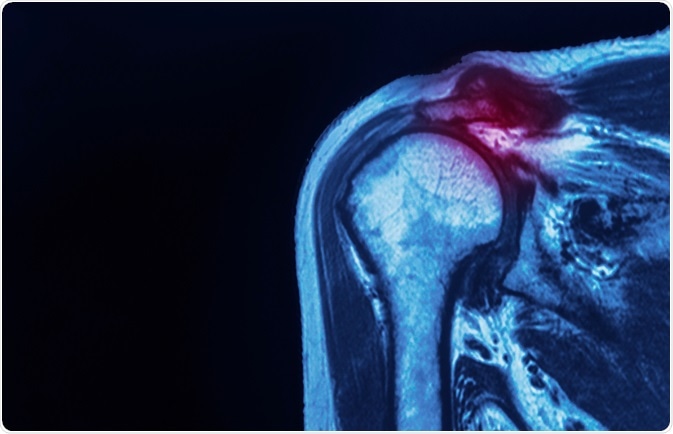Shoulder pain is the third most frequent musculoskeletal symptom encountered in medical practice after back and neck pain. A wide range of potential pathological entities can give rise to shoulder pain; rotator cuff tear and impingement are among the main causes.
The rotator cuff plays a pivotal role in the static and dynamic stability of the glenohumeral joint. Its dysfunction is important as it occurs frequently and may necessitate surgical management. In addition, when operative intervention is pursued, there is the question as to what technique of repair should be employed.
 MRI of a human shoulder, with rotator cuff, highlighted. Image Credit: Peter Porrini / Shutterstock.com
MRI of a human shoulder, with rotator cuff, highlighted. Image Credit: Peter Porrini / Shutterstock.comRotator cuff tear
Rotator cuff tear represents one of the most common shoulder injuries in adult patients and a common contributing factor to shoulder pain and occupational disability. Ultrasound scanning has revealed that 13% of the population in the fifth decade, 20% in the sixth decade and more than 30% in the seventh decade of life have a rotator cuff tear.
Three stages of rotator cuff disease are usually described. The first stage occurs in patients younger than 25 years with hemorrhage and edema of the tendon and bursa. The second stage involves tendinitis and fibrosis of the rotator cuff in patients between 25 and 40 years of age. Finally, in the third stage, there is tearing of the rotator cuff (either partial or full-thickness), most often in patients older than 40 years of age.
The histopathological changes involved in cuff tendon rupture mostly occur progressively and gradually, except in the rare cases of acute traumatic avulsion. Partial tears are either interstitial (when the defect is entirely within the substance of the cuff) or communicating, denoting disruption of the tendon fibrils on the underside of the cuff with communication between the joint space and the defect.
With the exception of traumatic tear, it is evident that with aging multiple etiologic factors contribute to the degeneration and, ultimately, failure of the rotator cuff. Several studies identified certain demographic factors (increased age and body-mass index) and smoking as important contributors to the progression of rotator cuff tears.
Examination may demonstrate atrophy around the shoulder girdle secondary to chronic disuse, most often in the supraspinatus and infraspinatus fosse. Multiple imaging modalities such as radiography, ultrasound and magnetic resonance imaging are used to properly assess the status of the rotator cuff.
Rotator cuff impingement
Rotator cuff impingement represents a chronic process that manifests as shoulder pain which can progress to permanent changes and potential tearing of the rotator cuff if left untreated. The condition can be classified into external, internal and secondary (or non-outlet) impingement syndrome.
External or outlet impingement is the most common form of this condition, caused by the compression of the rotator cuff tendons as they pass below the coracoacromial arch. Internal impingement is a result of undersurface fraying of the infraspinatus tendon when the arm is placed in maximal abduction and external rotation.
Secondary or non-outlet impingement represents a dynamic process caused by slight glenohumeral instability. Subtle subluxation of the humeral head that occurs as a result of the activity can seriously narrow the humeroacromial interface and therefore lead to impingement symptoms.
The exact etiology of the abovementioned impingement syndromes has not yet been adequately explained. Suspected predisposing causes are strenuous physical work, long periods of working with the arms above the head, or sports which require the arms to be raised above the head with subsequent functional instability.
Rotator Cuff Injuries | Complete Anatomy
Treatment modalities
The management of rotator cuff tears is complex and multifactorial. Physiotherapy represents the mainstay of conservative management of rotator cuff tears. Operative treatment allows primary repair to be performed either by a mini-open or arthroscopic procedure.
Improvements in arthroscopic instrumentation and suture anchor technology have resulted in the repair of large and massive tears through minimally invasive means. In order to enhance tendon tissue regeneration, novel biological solutions – including platelet-rich plasma, growth factors and stem cells – are being investigated.
The treatment choice for rotator cuff impingement is conservative and varies with the stage of the complaint, the level of progression and the level of shoulder motion involved in the patient’s daily activity. The patient should be given a basic exercise program with an initial emphasis on isometric strengthening of the supraspinatus and infraspinatus muscles.
References
Further Reading
Last Updated: Nov 21, 2022